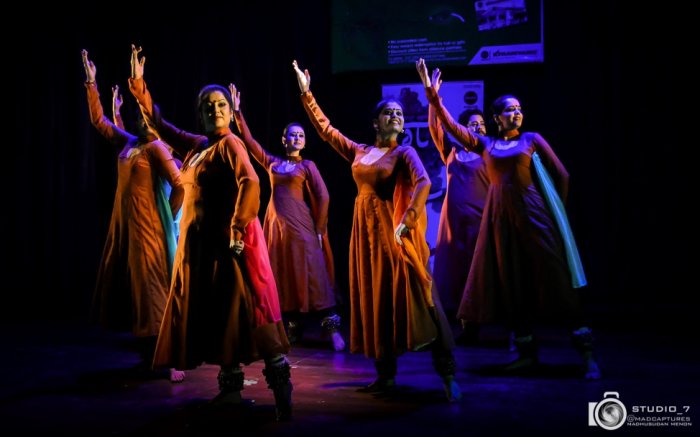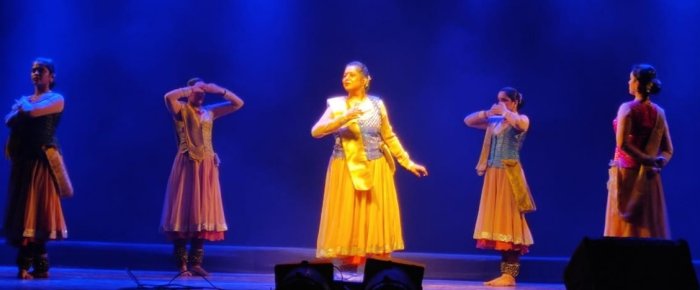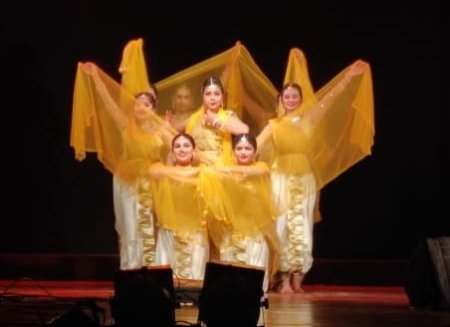
|   |

|   |
Rang: The colours of dance - Vijay Shanker e-mail: vijaydance@gmail.com January 6, 2023 Veteran Kathak mentor and exponent Asha Joglekar was one of the foremost Kathak exponents of Mumbai, over the decades of her valuable and outstanding contribution towards enrichment, propagation and promotion of classical dance. She has trained several dance aspirants and many of them have become professionals today and teachers too. Her two disciples Maneesha Jeet and Lata Bakalakar paid tributes to their beloved teacher, fondly known as Mavshi to all, by launching the 'Guru Smt Asha Joglekar Nrityotsav 2022' on 30th November at Veer Savarkar auditorium in Mumbai. This was a humble attempt to pay tributes to the legacy of their Guru and also to honour gurus whose lives has been a constant source of learning and inspiration. This year, the event started with "Rang, nrithyaache, manaache, bhaavaamche..." a production based on the universality of human emotions with a holistic perspective, presented and performed by Manisha, Lata and their disciples. Rang is a marriage of emotions and colours used to display the flavour of various moods in the Kathak dance style. The production commenced with a poem portraying the enormity of emotions and how even the intangible and abstract have different shades to it. The performers personified the colours as their expression, as each colour has its specific significance.  Red The colour 'red' was used to portray bravery, valour and sacrifice of the character Abhimanyu from Mahabharata. Abhimanyu's determination, all the obstacles that he faces is being overpowered by his opponents and the resolve and tenacity of his spirit was celebrated with the underlying colour red with vibrant and lively movements by the dancers. Envy and jealousy was displayed through the colour purple. The poem, "Aagadi ani Jamin" by the legendary Kusumagraj was used to show the distinctly different characters - the earth and a train. The train, inflicted with arrogance, induces to enhance the earth repeatedly; the earth after a lot of inflictions, merely shakes and the train falls to her doom. Freedom was depicted using the colour blue. Incorporating the vastness of the blue sky and the massiveness of the ocean, the colour blue symbolises self-determination. The dancers used the imagery of breaking bondage to symbolize this. The concluding piece was the "Avagha ranga ek zhala" (Oneness of colours) by the stalwart Kishori Amonkar, which is etched in our hearts. The piece represented the oneness of all the emotions, transcending the edges of the mundane and leading the soul towards the ultimate. The most noteworthy aspect of the dancers is the teamwork and the uniformity of movements that makes the entire presentation quite spectacular. Manisha Jeet is indeed among the best choreographers of the city, with innovative ideas and exuberant presentations.  Blue The second half of the event was to honour the senior Kathak exponent Guru Rajashri Shirke, who performed with her senior students. She left the audience spellbound with her dramatic and intense production, 'Sant Kanhopatra' in which the dancer portrays how the devotee merges with the divine.. Items choreographed by Lata Bakalkar picturized the green colour in its varied forms and manifestations. This creative color is a continuous process of growth and development. Creation is endless, creation has no demise, the entire circle of life is governed by it. Evolution in nature is a cyclic process which never stops. Seasons fade and become out of sight only to return with brighter blossoms. This metaphor can be aesthetically used in various art forms, especially dance. Taal, jati, jaati, layakari, are similar to the various cycles in nature. Dance advances in different speeds, being vilambit (slow), madhya (medium) and drut laya (fast tempo) to reach the crescendo, similar to the Bloomingdale flower. Just like nature's beauty is best enjoyed at its pinnacle, dance as art is thrilling with intricate rhythmic patterns that ultimately concludes with the grand finale of rhythmic fantasy. Black colour is symbolic of darkness, ignorance, suffering, misery and night. As the dark night ultimately concludes with the dawn and the radiance of the rising sun, similarly life too has its varied shades of both progress and regress. It was exciting to see dancers change different expressions in split seconds.  Yellow One of the most auspicious colours is yellow, hence used in social and religious occasions. The colour yellow projects the mystic beauty of the sun's rays that illuminate the entire universe. Vithoba gracefully attired in his Pitamber and golden Kasturi tilak flashing on his forehead, yellow marigold to mark auspicious occasions and amber clothing to embrace new beginnings, all showcase the importance of this joyous yellow colour in Indian culture and traditions. The bright light guiding through dark times resonates the colour yellow. The path of spiritual awakening, of trust in the supreme Almighty is always lit with a golden glow. Yellow colour represents the pious feeling of positivity, the innocent touch of goodwill and the complete surrender to the divine was the grand finale to the performance.  Vijay Shankar is a Kuchipudi and Kathakali exponent, teacher, bilingual journalist, arts critic and actor. |